Liver disease profiles: short statistical commentary, November 2018
Published 6 November 2018
New in this update
This update includes new data for these mortality and vaccination coverage indicators:
- mortality from liver disease in persons, males and females aged under 75
- mortality from alcoholic liver disease in persons, males and females aged under 75
- percentage of eligible children who received 4 doses of hepatitis B vaccine at any time by their second birthday
- mortality from hepatitis B related end-stage liver disease or hepatocellular carcinoma in persons aged under 75
- mortality from hepatitis C related end-stage liver disease or hepatocellular carcinoma in persons aged under 75
- mortality from non-alcoholic fatty liver disease (NAFLD) in persons aged under 75
Mortality data for the years 2015 to 2017 have been added for the first time. The previous data has been fully revised to take into account the revision of the Office for National Statistics mid-year population estimates.
Additional data back to 2007 to 2010 has also been newly added for three of the indicators, hepatitis B, C and NAFLD to give a more comprehensive trend view.
Main findings
This update shows:
- liver disease kills more people every year
- in 2015 to 2017, there were 26,265 premature deaths due to liver disease in England, a rate of 18.5 per 100,000 population under the age of 75
- rates of premature alcoholic liver disease mortality are significantly higher in males (11.9 per 100,000 population aged under 75) than females (6.1 per 100,000 population aged under 75)
- hepatitis B vaccination coverage data showed 31 UTLA areas with 100% coverage
- the gap between the most and least deprived UTLA deciles for the rates of premature hepatitis B mortality has narrowed
- during 2015 to 2017, the rate of deaths in those aged under 75 from hepatitis C related end-stage liver disease or liver cancer was 0.6 per 100,000 population in England (966 deaths)
- Blackburn with Darwen UTLA had the highest rates (4.5 per 100,000 population) of people dying prematurely from non-alcoholic fatty liver disease.
Summary
Premature mortality rate due to liver disease
This indicator has been updated and previous data refreshed to present data from between 2001 to 2003 to 2015 to 2017 for males, females and persons. This indicator highlights the premature deaths caused by a largely preventable disease in each lower and upper tier local area.
In 2015 to 2017 the rate of premature mortality due to liver disease was 18.5 per 100,000 population aged under 75 in England. This represents on average over 8,700 lives lost due to liver disease a year.
The rate has been progressively increasing from 2001 to 2003 when the rate was 15.8 per 100,000 population aged under 75 across England, accounting for almost 6,400 deaths a year.
Figure 1: Mortality rate due to liver disease, per 100,000 population age under 75, England, from 2001 to 2003 to 2015 to 2017
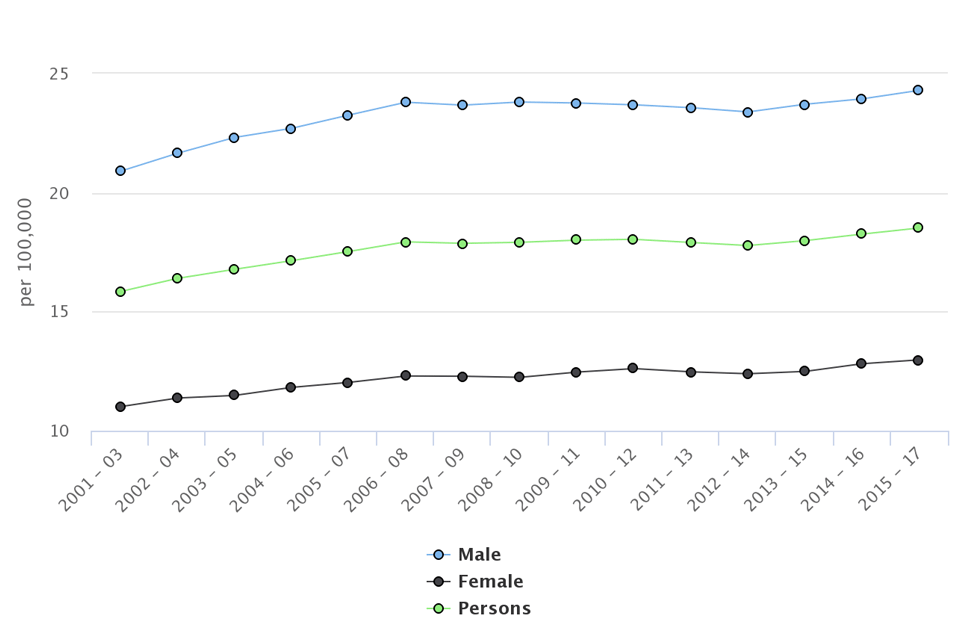
Line chart showing the mortality rate per 100,000 population aged under 75 in England for males, females and persons separately, from 2001 to 2003 (aggregated) up to 2015 to 2017 (aggregated).
Liver disease continues to claim more lives each year. Males in 2015 to 2017, experienced a rate of 24.3 deaths per 100,000, a rate twice as high as females (13.0 per 100,000).
Across the UTLAs rates varied from the highest rate 46.0 per 100,000 population in Blackpool to 10.5 in Bracknell Forest. Lancashire had the largest count of deaths from liver disease with 809 deaths in 2015 to 2017. Areas experiencing more deprivation have much higher rates of death from liver disease. Those in the most deprived districts have a rate (25.8 per 100,000 people aged over 75) that is twice that of the least deprived districts (12.3 per 100,000 people aged over 75).
Figure 2: Mortality rate due to liver disease, per 100,000 population aged under 75, by lower tier local authority deprivation decile, England, 2015 to 2017

Bar chart showing mortality rate due to liver disease, per 100,000 population aged under 75 for each lower tier local authority deprivation decile in England for 2015 to 2017 (aggregated).
Premature mortality due to alcoholic liver disease
This indicator has been updated and previous data refreshed to present data from the year 2001 to 2003, up to 2015 to 2017 for males, females and persons.
In England, the rate of mortality from alcoholic liver disease was 9.0 per 100,000 people aged under 75, a count of 12,812 deaths.
The mortality rate for alcoholic liver disease has been increasing since 2012 to 2014 and in 2015 to 2017 is significantly higher.
Figure 3: Mortality rate from alcoholic liver disease, per 100,000 population aged under 75, England, 2001 to 2003 to 2015 to 2017
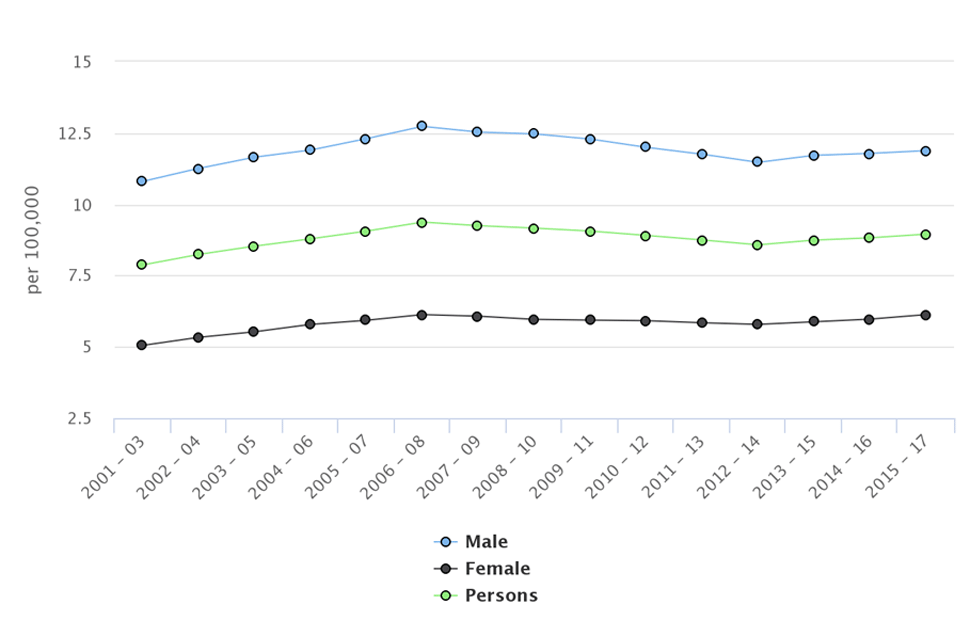
Line chart showing mortality rate from alcoholic liver disease, per 100,000 population aged under 75 for England for males, females and persons separately, from 2001 to 2003 (aggregated) to 2015 to 2017 (aggregated).
Rates of premature alcoholic liver disease mortality are significantly higher in males (11.9 per 100,000 population aged under 75) than for females (6.1 per 100,000 population aged under 75).
Across the county and unitary authorities rates varied from 3.2 per 100,000 population aged under 75 in Barnet to 28.1 in Blackpool (figure 4). The rate for Blackpool was 1.4 times higher than the next highest rate, of 19.7 per 100,000 population aged under 75, experienced in Tameside.
Regionally the northern areas tended to have higher rates than in the southern regions.
Figure 4: Under 75 alcoholic liver disease mortality rate, per 100,000 population, upper tier local authorities, 2015 to 2017
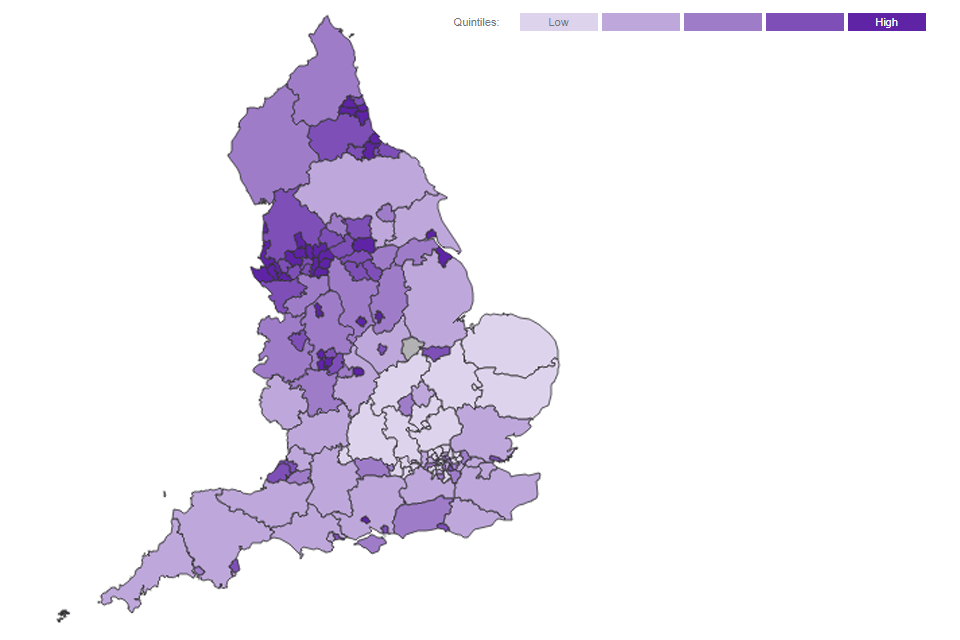
Map showing mortality rate from alcoholic liver disease per 100,000 population for each upper tier local authority in England, shaded by mortality rate quintile, from low to high, for 2015 to 2017 (aggregated).
Percentage of eligible children who received 4 doses of hepatitis B vaccine at any time by their second birthday
Hepatitis B vaccinations are given to babies born to mothers who are known to have hepatitis B infection as a preventative measure. If a person develops chronic hepatitis B, around a fifth will eventually develop liver cirrhosis and a tenth of these will get liver cancer.
31 of the 152 upper-tier local authority areas had 100% vaccination coverage. For 40 areas coverage was unable to be reported due to missing data or data quality reasons. Amongst the areas that did report, Bury had the lowest level of coverage, 11.3% of eligible patients.
Premature mortality from hepatitis B related end-stage liver disease or hepatocellular carcinoma
199 premature deaths from hepatitis B related end-stage liver disease or hepatocellular carcinoma occurred from 2015 to 2017 in England, a rate of 0.13 per 100,000 population aged over 75.
Rates of mortality varied across the deprivation deciles and though rates are higher in the most deprived deprivation decile than the least deprived decile, the gap has been narrowing (figure 5).
Figure 5: Hepatitis B related end-stage liver disease or hepatocellular carcinoma disease mortality rate, per 100,000 population aged under 75, 2015 to 2017 by most and least deprived deprivation decile over time.
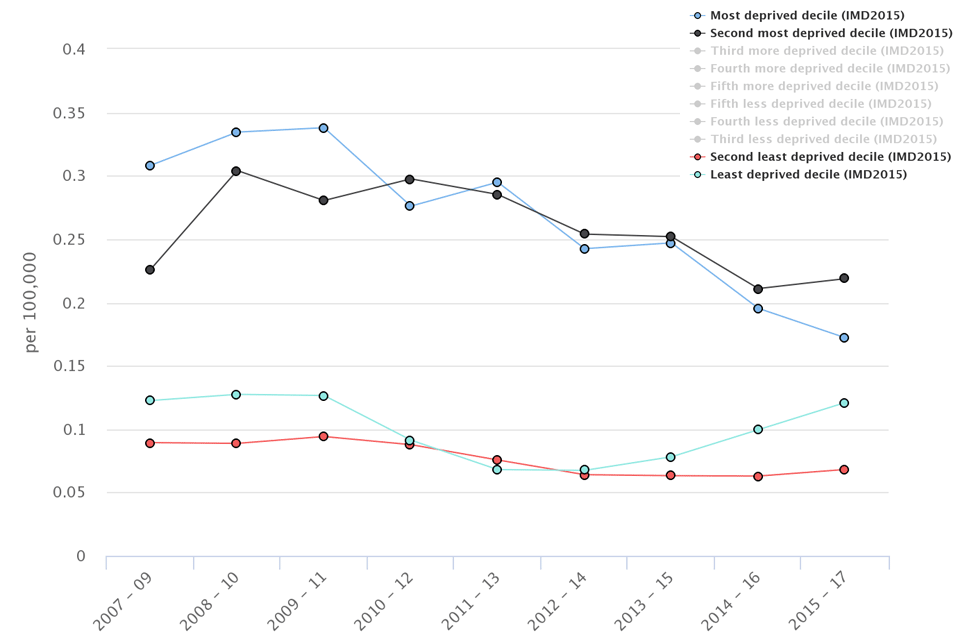
Line chart showing mortality rate per 100,000 population aged under 75 due to Hepatitis B related end-stage liver disease and hepatocellular carcinoma disease, 2007 to 2009 up to 2015 to 2017 (aggregated) for most and least deprived deciles.
Premature mortality from hepatitis C related end-stage liver disease or hepatocellular carcinoma
About three-quarters of people infected with acute hepatitis C develop a chronic condition that can lead to end-stage liver disease or liver cancer[footnote 1]. During 2015 to 2017, the rate of deaths in those aged under 75 from hepatitis C related end-stage liver disease or liver cancer was 0.63 per 100,000 population in England (966 deaths).
The mortality trend has not changed significantly at the national level since 2010 to 2012. However rates have started to plateau.
Across the upper tier local authority areas, Kensington and Chelsea had the highest mortalities of 2.5 per 100,000 people aged under 75, followed by Bournemouth with a rate of 2.1, both areas were significantly worse than the England average.
Premature mortality due to non-alcoholic fatty liver disease
In England 774 people died due to non-alcoholic fatty liver disease, a rate of 0.51 per 100,000 population aged under 75.
Rates were 5 times higher in the North West region (1.3 per 100,000 aged under 75) than the South West (0.26 per 100,000 aged under 75).
Across the upper tier local authority areas, Blackburn with Darwen had the highest rate at 4.5 per 100,000 people aged under 75, Lancashire had the highest number of deaths at 77.
Figure 6: Under 75 non- alcoholic fatty liver disease mortality rate, per 100,000 population, upper tier local authorities in the North West region, 2015 to 2017
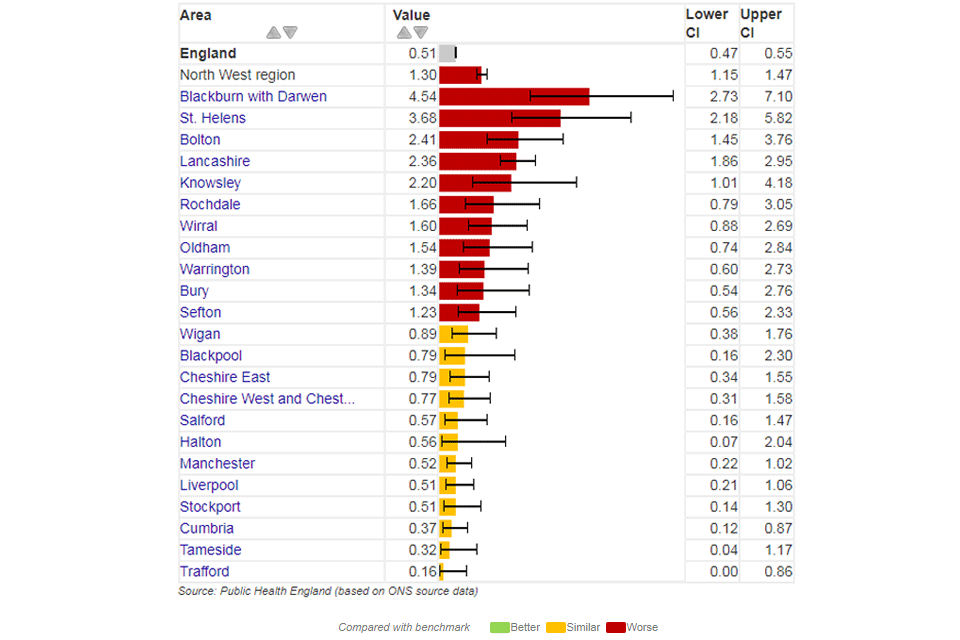
Bar chart showing non-alcoholic fatty liver disease mortality rate, per 100,000 population aged under 75, for North West upper tier local authorities and compared to England average, 2015 to 2017 (combined)..
Background and further information
Liver disease is almost entirely preventable with the major risk factors: alcohol, obesity and hepatitis B and C accounting for up to 90% of cases.
The liver disease profiles provide an invaluable resource relating to one of the main causes of premature mortality nationally; a disease whose mortality rates are increasing in England, while decreasing in most EU countries.
The local authority profiles will support the development of Joint Strategic Needs Assessments and work of health and wellbeing boards presenting local key statistics and highlighting questions to ask locally about current action to prevent liver disease.
The website contains data for upper tier local authorities, former Government Office regions, England and where available lower tier local authorities.
The profiles, aimed at primarily LAPH were developed following recommendations in March 2014 from the All-Party Parliamentary Hepatology Group (APPHG) inquiry into improving outcomes in liver disease.
Recommendations the LA profiles aim to address were:
- PHE should address the worrying lack of data on all aspects of liver disease by developing a dataset to allow performance management of liver disease across CCGs, local authorities and health and wellbeing boards
- health and wellbeing boards should monitor early detection, treatment and mortality rates from liver disease; assessing progress on tackling liver disease should be made a mandatory part of the joint strategic planning process for CCGs and local authorities
Further details about the profile methodology are available within the definitions section of the online version of the liver disease profile.
Responsible statistician, product lead: Liz Rolfe, Julia Verne
For queries relating to this document, please contact: liverdisease@phe.gov.uk
